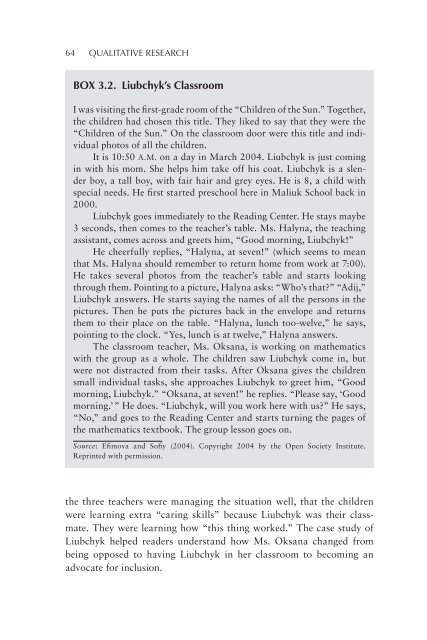How Things Work - Doha Academy of Tertiary Studies
How Things Work - Doha Academy of Tertiary Studies
How Things Work - Doha Academy of Tertiary Studies
You also want an ePaper? Increase the reach of your titles
YUMPU automatically turns print PDFs into web optimized ePapers that Google loves.
64 QUaLItatIVe ReSeaRCH<br />
BOX 3.2. liubchyk’s classroom<br />
I was visiting the first-grade room <strong>of</strong> the “Children <strong>of</strong> the Sun.” Together,<br />
the children had chosen this title. They liked to say that they were the<br />
“Children <strong>of</strong> the Sun.” On the classroom door were this title and individual<br />
photos <strong>of</strong> all the children.<br />
It is 10:50 A.M. on a day in March 2004. Liubchyk is just coming<br />
in with his mom. She helps him take <strong>of</strong>f his coat. Liubchyk is a slender<br />
boy, a tall boy, with fair hair and grey eyes. He is 8, a child with<br />
special needs. He first started preschool here in Maliuk School back in<br />
2000.<br />
Liubchyk goes immediately to the Reading Center. He stays maybe<br />
3 seconds, then comes to the teacher’s table. Ms. Halyna, the teaching<br />
assistant, comes across and greets him, “Good morning, Liubchyk!”<br />
He cheerfully replies, “Halyna, at seven!” (which seems to mean<br />
that Ms. Halyna should remember to return home from work at 7:00).<br />
He takes several photos from the teacher’s table and starts looking<br />
through them. Pointing to a picture, Halyna asks: “Who’s that?” “Adij,”<br />
Liubchyk answers. He starts saying the names <strong>of</strong> all the persons in the<br />
pictures. Then he puts the pictures back in the envelope and returns<br />
them to their place on the table. “Halyna, lunch too-welve,” he says,<br />
pointing to the clock. “Yes, lunch is at twelve,” Halyna answers.<br />
The classroom teacher, Ms. Oksana, is working on mathematics<br />
with the group as a whole. The children saw Liubchyk come in, but<br />
were not distracted from their tasks. After Oksana gives the children<br />
small individual tasks, she approaches Liubchyk to greet him, “Good<br />
morning, Liubchyk.” “Oksana, at seven!” he replies. “Please say, ‘Good<br />
morning.’ ” He does. “Liubchyk, will you work here with us?” He says,<br />
“No,” and goes to the Reading Center and starts turning the pages <strong>of</strong><br />
the mathematics textbook. The group lesson goes on.<br />
Source: Efimova and S<strong>of</strong>iy (2004). Copyright 2004 by the Open Society Institute.<br />
Reprinted with permission.<br />
the three teachers were managing the situation well, that the children<br />
were learning extra “caring skills” because Liubchyk was their classmate.<br />
They were learning how “this thing worked.” The case study <strong>of</strong><br />
Liubchyk helped readers understand how Ms. Oksana changed from<br />
being opposed to having Liubchyk in her classroom to becoming an<br />
advocate for inclusion.

















